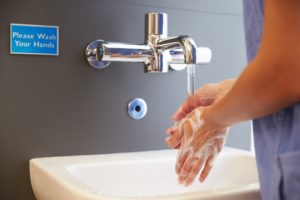Interventional Care


We notice that you are visiting us from . This site only services US-based visitors. Would you like to visit the site that is appropriate for your location?

The single most effective way to prevent the spread of disease is by performing hand hygiene. Since this seems so simple, why is there a need to annually promote clean hands by the World Health Organization (WHO) on May 5th? Great question, right?
For those of you working in healthcare, you may understand the need very well. Until the observations made by Dr. Ignaz Semmelweis (1840’s), regarding the transmission of agents of childbirth fever on the hands of the practicing physicians and medical students from bodies examined in autopsies to the women on the maternity ward, hand washing or hand hygiene was not a common practice in early healthcare. The relationship of clean hands reducing the risk of infection and saving lives was demonstrated by the physicians under Semmelweis’ charge, when he instructed them to wash their hands in a chlorinated lime solution before delivering babies. This simple act contributed to a dramatic reduction in mortality rates on his maternity ward. Unfortunately, the importance of his discovery was overshadowed by ridicule and disbelief by many of his colleagues, forcing Semmelweis to lose his position at the Vienna hospital and retreat to his native home of Budapest in 1850. [1]
Hand Hygiene in the Forefront
Since then, hand hygiene has certainly been in the forefront of infection prevention not only in healthcare, but in food safety, schools, and any venue involving the presence of the biggest source of infection: the human hands. Studies continue to show that healthcare workers wash their hands less than half of the times they should[2] contributing to healthcare-associated infections, many of which are due to multi-drug resistant organisms. According to WHO, of every 100 hospitalized patients, at least 7 in high-income and 10 in low-/middle-income countries will acquire a healthcare-associated infection[3]. Among critically ill and vulnerable patients in intensive care units, that figure rises to around 30 per 100.[4] Although, healthcare facilities implement hand hygiene protocols around the “5 Moments of hand hygiene” (1. before touching a patient 2. before clean and aseptic procedures 3. after contact with body fluids 4. after touching a patient 5. after touching patient surroundings)[5] and the availability of hand hygiene products, non-compliance continues to be an area noted for improvement on most infection prevention risk assessments.
The Centers for Disease Control and Prevention’s (CDC) campaign around clean hands promotes the importance of hand hygiene in healthcare settings as well. The CDC not only provides recommendations and guidelines for healthcare providers, but also encourages patients/visitors to be empowered in their own healthcare, especially around the subject of hand hygiene. The campaign suggests that hand hygiene be a topic of conversation between the healthcare provider and the patient. Healthcare providers might need to clean their hands as many as 100 times per 12-hour shift, depending on the number of patients and intensity of care.[6] An empowered patient can assist the healthcare provider in maintaining compliance with this potentially life-saving protocol. Hand hygiene is most effective when practiced by everyone, including patients and visitors alike.
Facts about Hand Hygiene
Hand hygiene involves not only washing hands with soap and water, but also the use of alcohol-based hand sanitizers. Alcohol-based hand sanitizers are available in various options from impregnated hand wipes, gels, foams, and rinses. All of these options supplement the need and the convenience of frequent hand hygiene in healthcare.
As we celebrate World Hand Hygiene Day on May 5th, it is important to understand the facts behind hand sanitizers. According to CDC,
As a consumer/patient, be empowered in your own healthcare. Expect your care takers to always perform hand hygiene and feel comfortable to have that conversation with physicians and all providers. Ensure that you have hand sanitizer available to clean your own hands, particularly if you are unable to get to a sink as frequently as needed.
Takes More Than a Village
It takes more than a village to combat life-threatening organisms that are transmitted on human hands every day. This is a call to action for the healthcare community, the public health community, the world health community, and for each and every individual to do their part in preventing the spread of disease and antibiotic resistance by these organisms. Remember, the single most effective way to prevent the spread of disease is by performing hand hygiene. Clean your hands often every day, throughout the day and help save lives!
[1] http://www.pbs.org/newshour/updates/ignaz-semmelweis-doctor-prescribed-hand-washing/
[2] https://www.cdc.gov/features/handhygiene/index.html
[3] http://www.who.int/mediacentre/news/releases/2014/hand-hygiene/en/
[4] http://www.who.int/mediacentre/news/releases/2014/hand-hygiene/en/
[5] http://www.who.int/mediacentre/news/releases/2014/hand-hygiene/en/
[6] https://www.cdc.gov/features/handhygiene/index.html
[7] https://www.cdc.gov/features/handhygiene/index.html